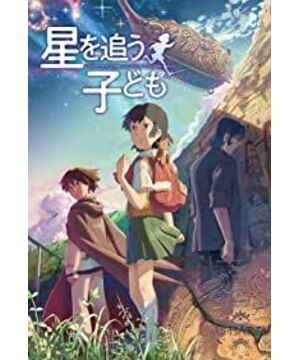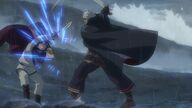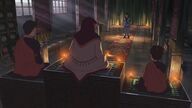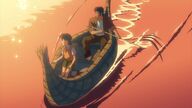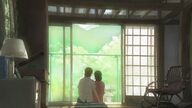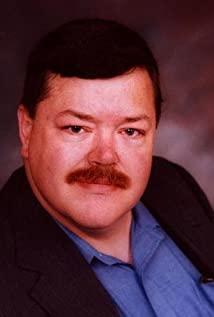Although I don’t know Xin Haicheng’s person, from his few works, he can see that in addition to scenes with high frequency such as stars, clouds, sunsets, and trams, he also has several other favorite things: school ( The other side of the cloud, 5 centimeters per second), cat (she and its story, the other side of the cloud, the assembly of cats), aircraft (the sound of the star, the other side of the cloud, 5 centimeters per second), weapons (the sound of the star, the cloud of the The other side), the mysterious ruins of ancient times (the voice of the stars, the other side of the clouds), etc. Xin Hai is really devoted to this work, because all the above elements appear in this work, and the length is not small. However, the result of pursuing big and comprehensive is often the lack of completeness and unity, so this work is quite a hodgepodge style. The film uses a lot of space to render ordinary and peaceful daily life. Just after the audience defaulted to such a realistic world setting, various opposing elements suddenly appeared: the fierce battle of armed helicopters, the magical and strange underground world, just like Miyazaki. The monsters in Jun's writings, the cold weapon decisive battle of electric light and flint... The big turn in style can indeed highlight the complexity of the worldview setting, which is conducive to conveying more information to the audience and experiencing more artistic conceptions and thoughts that the supervisor wants to present; but watch it It is quite uncomfortable at times, and people can't help thinking about whether the worldview setting of the work is too complicated and whether there is still room for improvement in the narrative method. Supervisor Xin Haicheng wants to make the work perfect and comprehensive, which is good, but it is too late and ruined the work. In this regard, I personally think that we can refer to the narrative structure and length of Spirited Away.
As early as in the era of "The End of the Cloud, the Promised Place", Xinhaicheng was criticized for "the narrative ability of long-form works was not strong". Naturally, for such a complex setting, the fragmentary sense of the film has not disappeared, but it has become more and more obvious. The sense of fragmentation is first reflected in the narrative rhythm. Looking at the film as a whole, the sense of relaxation is not good. There are many clips that suddenly go to a small orgasm and suddenly fall. It is like a sudden erection but comes out in 10 seconds, which is somewhat inexplicable. Perhaps it is because the worldview and plot settings in the script are indeed too large, so many plots can only be simplified and cannot be described in detail. This brings about another problem, that is, many puzzles are not explained in detail or simply not explained, and many plots seem unbelievable or incomprehensible, and the audience naturally feels "inexplicable". Furthermore, the sense of fragmentation is also reflected in the narrative of several branches, and the sense of continuity of switching is not good. The film repeatedly uses the transition effect of fade to black. In fact, this transition is more suitable for ending. Under normal circumstances, the transition should be made through the connection between the lines, instead of using this method that is very easy to destroy the integrity of the work. . Regarding the feeling of brokenness, it can also be clearly felt from the OST. In the OST of the previous works, each track is an emotional and well-structured work, but most of the tracks in this work contain many scenes and emotions, which are very jumpy and completely serve the plot. They are really just "OST". Here I want to talk about "Spirited Away", the typical plot is messy but organized, it is a masterpiece of scattered style but not scattered.
In addition, this work can really add a subtitle like this: Tribute to Hayao Miyazaki and Hideaki Anno! The shadows of Ghibli and EVA can be seen everywhere in the film, so that it feels like this: the actors are Ghibli guest appearances, especially the male protagonist is like Hall in "Howell's Moving Castle" and like "The Ghost" The flying bird in "Princess"; the realistic landscape is the Ghibli-style grassland + Xinhaicheng-style sky, and the scenery of the underground world is the Ghibli-style wilderness grassland + Xinhaicheng-style sky; the cultural landscape of the underground world is even more so Familiar: the liquid that can breathe into the lungs like LCL, the ancient giant possessed by Lilith, the monsters and spaceships that are very Ghibli wind, and even the period of the duel between the heart and the monk reminds me of the birds and the cavalry in "Princess Mononoke". In the scene of the samurai confrontation, the plot about returning from the dead reminds me of "Fullmetal Alchemist"... This is also the reason why I said that this work lacks the spirituality that Shinkai Makoto should have. These story settings and character settings are real. It's too common, except for the iconic starry sky and sea of clouds, it really lacks elements that belong to Xin Haicheng's unique style.
So, the last and most important point I want to say is that this work lacks the feeling that Xin Haicheng’s work has always brought me—about innocent resonance and moving. Most people who like Xin Haicheng say that "like his style" is the appearance. The most important thing is that his style can resonate and can remind people of those very ordinary people and things that are shining brightly in the depth of memory. "The Other Side of the Cloud, The Promised Place" is both a full-length, fantasy-like work, but the realism in the first half of the work is very resonant and very yearning, and the second half of science fiction is not important, and the focus is still three. Human feelings and fetters, under the premise of resonance, the audience will subconsciously take this second half of the illusory but romantic and innocent story as a kind of vision and hope to make up for their own reality shortcomings. This technique is perfect. , Very wonderful. "5 Centimeters Per Second" is more proficient in this aspect. Xin Haicheng uses such a beautiful technique to tell the ordinary emotional stories that seem to belong to everyone. These three stories did not even start and end, but there are some incompleteness. After passing, but it is also because of this that it has a very strong resonance with the audience, as if Xin Haicheng used his wonderful world to create such a work for your story. However, what about this new work? First of all, I did not understand what Xin Haicheng wanted to express with this work. It seems that the theme of the whole work is "Living is happy, cherish the people around you now. PS Don't obsess about the people who have passed away." However, the title "Children Chasing the Stars" seems to refer to the moment who ran to the ground for the stars, and this is an act of being dissatisfied with the present and actively exploring the world, and it cannot be combined with the former. But these are all secondary. No matter what I wanted to express, I didn't get any sympathy from this work, and I didn't find the soul of Xin Haicheng's work that was throbbing like in the previous work.
Although the unclear connotation and uninspired narrative make this work seem less spiritual than the previous work, Xin Haicheng’s world is still so beautiful, full of flashing memories and longings; for me, this work is worthy of fans. Xin Haicheng has brought his iconic style of light and shadow to the extreme. Those gorgeous starry sky and glowing sunset make people fascinated, as if leaving the hustle and bustle and returning to the countryside, the whole person has been purified; the magical villages, ruins, and sky described by Xin Hai Waiting is also very interesting. Sometimes I feel that Xin Haicheng’s pictures are a pleasure to look at. As long as the atmosphere is correct, I actually don’t really care whether his plot is complete and smooth. In any case, this work is the work of Xinhai. As a new sea fan, the two-hour tour of Xinhai World under the giant screen is still an intoxicating and moving experience.
After the BD version is released, I will drag it down and watch it again.
View more about Children Who Chase Lost Voices reviews


